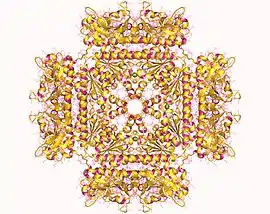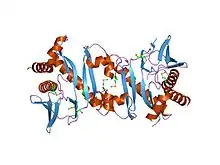| SAICAR synthase | |||||||||
|---|---|---|---|---|---|---|---|---|---|
 Phosphoribosylaminoimidazole succinocarboxamide synthetase oktamer, Human | |||||||||
| Identifiers | |||||||||
| EC no. | 6.3.2.6 | ||||||||
| CAS no. | 9023-67-0 | ||||||||
| Databases | |||||||||
| IntEnz | IntEnz view | ||||||||
| BRENDA | BRENDA entry | ||||||||
| ExPASy | NiceZyme view | ||||||||
| KEGG | KEGG entry | ||||||||
| MetaCyc | metabolic pathway | ||||||||
| PRIAM | profile | ||||||||
| PDB structures | RCSB PDB PDBe PDBsum | ||||||||
| Gene Ontology | AmiGO / QuickGO | ||||||||
| |||||||||
| SAICAR synthetase | |||||||||
|---|---|---|---|---|---|---|---|---|---|
 Structural genomics, protein TM1243, (SAICAR synthetase) | |||||||||
| Identifiers | |||||||||
| Symbol | SAICAR_synt | ||||||||
| Pfam | PF01259 | ||||||||
| InterPro | IPR001636 | ||||||||
| PROSITE | PDOC00810 | ||||||||
| SCOP2 | 1a48 / SCOPe / SUPFAM | ||||||||
| CDD | cd00476 | ||||||||
| |||||||||
In molecular biology, the protein domain SAICAR synthase is an enzyme which catalyses a reaction to create SAICAR. In enzymology, this enzyme is also known as phosphoribosylaminoimidazolesuccinocarboxamide synthase (EC 6.3.2.6). It is an enzyme that catalyzes the chemical reaction
- ATP + 5-amino-1-(5-phospho-D-ribosyl)imidazole-4-carboxylate + L-aspartate ADP + phosphate + (S)-2-[5-amino-1-(5-phospho-D-ribosyl)imidazole-4-carboxamido]succinate
The 3 substrates of this enzyme are ATP, 5-amino-1-(5-phospho-D-ribosyl)imidazole-4-carboxylate, and L-aspartate, whereas its 3 products are ADP, phosphate, and (S)-2-[5-amino-1-(5-phospho-D-ribosyl)imidazole-4-carboxamido]succinate.
This enzyme belongs to the family of ligases, to be specific those forming carbon-nitrogen bonds as acid-D-amino-acid ligases (peptide synthases). The systematic name of this enzyme class is 5-amino-1-(5-phospho-D-ribosyl)imidazole-4-carboxylate:L-aspartate ligase (ADP-forming). This enzyme participates in purine metabolism.
This particular protein family is of huge importance as it is found in all three domains of life. It is the seventh step in the pathway of purine biosynthesis. Purines are vital to all cells as they are involved in energy metabolism and DNA synthesis.[1] Furthermore, they are of specific interest to scientific researchers as the study of the purine biosynthesis pathway could lead to the development of chemotherapeutic drugs.[2] This is because most cancers lack a salvage pathway for adenine nucleotides and rely entirely on the SAICAR pathway.[3]
Protein domain
This protein domain is found in eukaryotes, bacteria and archaea. It is vital for living organisms since it catalyses a step in the purine biosynthesis pathway which aids energy metabolism and DNA synthesis.
Protein domain function
In bacteria and plants this protein domain only catalyses the synthesis of SAICAR. However, in mammals it also catalyses phosphoribosylaminoimidazole carboxylase (AIRC) activity.[3]
Protein domain structure
This particular protein is an octamer made up of 8 identical subunits. Each monomer consists of a central domain and a C-terminal alpha helix. The central domain consists of a five-stranded parallel beta sheet flanked by three alpha helices one side of the sheet and two alpha helices on the other, forming a three-layer (alpha beta alpha) sandwich.[4]
Structural studies
As of late 2007, 10 structures have been solved for this class of enzymes, with PDB accession codes 1A48, 1KUT, 1OBD, 1OBG, 2CNQ, 2CNU, 2CNV, 2GQR, 2GQS, and 2H31.
Other common names
- phosphoribosylaminoimidazole-succinocarboxamide synthetase,
- PurC,
- SAICAR synthetase,
- 4-(N-succinocarboxamide)-5-aminoimidazole synthetase,
- 4-[(N-succinylamino)carbonyl]-5-aminoimidazole ribonucleotide,
- synthetase,
- SAICARs,
- phosphoribosylaminoimidazolesuccinocarboxamide synthetase,
- 5-aminoimidazole-4-N-succinocarboxamide ribonucleotide synthetase.
References
- ↑ Brown AM, Hoopes SL, White RH, Sarisky CA (2011). "Purine biosynthesis in archaea: variations on a theme". Biol Direct. 6: 63. doi:10.1186/1745-6150-6-63. PMC 3261824. PMID 22168471.
- ↑ Cheng X, Lu G, Qi J, Cheng H, Gao F, Wang J, et al. (2010). "Cloning, expression, purification, crystallization and preliminary X-ray diffraction analysis of SAICAR synthase from Streptococcus suis serotype 2". Acta Crystallogr F. 66 (Pt 8): 909–12. doi:10.1107/S1744309110020518. PMC 2917288. PMID 20693665.
- 1 2 Ginder ND, Binkowski DJ, Fromm HJ, Honzatko RB (2006). "Nucleotide complexes of Escherichia coli phosphoribosylaminoimidazole succinocarboxamide synthetase". J Biol Chem. 281 (30): 20680–8. doi:10.1074/jbc.M602109200. PMID 16687397.
- ↑ Mathews II, Kappock TJ, Stubbe J, Ealick SE (1999). "Crystal structure of Escherichia coli PurE, an unusual mutase in the purine biosynthetic pathway". Structure. 7 (11): 1395–406. doi:10.1016/S0969-2126(00)80029-5. PMID 10574791.
- LUKENS LN, BUCHANAN JM (1959). "Biosynthesis of the purines. XXIV. The enzymatic synthesis of 5-amino-1-ribosyl-4-imidazolecarboxylic acid 5'-phosphate from 5-amino-1-ribosylimidazole 5'-phosphate and carbon dioxide". J. Biol. Chem. 234 (7): 1799–805. doi:10.1016/S0021-9258(18)69929-6. PMID 13672967.
- Parker J (1984). "Identification of the purC gene product of Escherichia coli". J. Bacteriol. 157 (3): 712–7. doi:10.1128/JB.157.3.712-717.1984. PMC 215316. PMID 6365889.
- Ebbole DJ, Zalkin H (1987). "Cloning and characterization of a 12-gene cluster from Bacillus subtilis encoding nine enzymes for de novo purine nucleotide synthesis". J. Biol. Chem. 262 (17): 8274–87. doi:10.1016/S0021-9258(18)47560-6. PMID 3036807.
- Chen ZD, Dixon JE, Zalkin H (1990). "Cloning of a chicken liver cDNA encoding 5-aminoimidazole ribonucleotide carboxylase and 5-aminoimidazole-4-N-succinocarboxamide ribonucleotide synthetase by functional complementation of Escherichia coli pur mutants". Proc. Natl. Acad. Sci. U.S.A. 87 (8): 3097–101. Bibcode:1990PNAS...87.3097C. doi:10.1073/pnas.87.8.3097. PMC 53841. PMID 1691501.
- O'Donnell AF, Tiong S, Nash D, Clark DV (2000). "The Drosophila melanogaster ade5 gene encodes a bifunctional enzyme for two steps in the de novo purine synthesis pathway". Genetics. 154 (3): 1239–53. doi:10.1093/genetics/154.3.1239. PMC 1460979. PMID 10757766.
- Nelson SW, Binkowski DJ, Honzatko RB, Fromm HJ (2005). "Mechanism of action of Escherichia coli phosphoribosylaminoimidazolesuccinocarboxamide synthetase". Biochemistry. 44 (2): 766–74. doi:10.1021/bi048191w. PMID 15641804. S2CID 41673787.